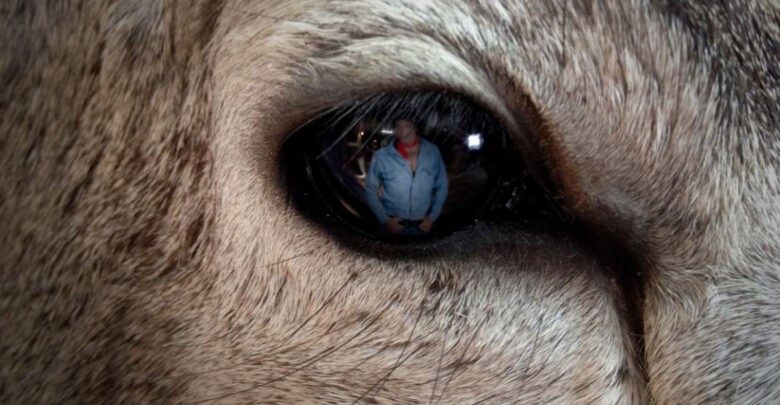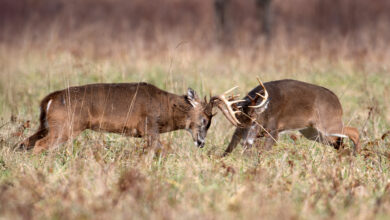
Hey there, fellow hunters! Today, we’re diving into the wild and wonderful world of Whitetail Vision. You might think you know your prey well, but trust me, these whitetail deer have some visual tricks up their hooves that you never knew about! So, let’s sharpen our senses and see things through their eyes to step up our hunting game in their natural whitetail deer habitat!
Discovering the Mysterious Whitetail Deer
The whitetail deer, scientifically known as Odocoileus virginianus, is a captivating member of the deer family, native to North and South America, with their primary habitat being in various environments like forests, fields, and meadows.
Read more: Improving Habitat For Whitetail
Their standout characteristics include the strikingly beautiful snow-white tail they raise as a signal, their incredible adaptability to these diverse habitats, and their medium-to-large size, with adult males weighing between 130 to 300 pounds and adult females weighing around 90 to 200 pounds. Notably, male whitetail deer grow impressive antlers, which they shed and regrow annually for breeding season purposes, a fact that makes them even more fascinating for hunters.
Read more: It’s Shed Season!
Decoding Whitetail Deer Sight
Rods and Cones: A Nighttime Advantage for Whitetail Deer Hunting.
Picture this: You’re out in the deer habitat, and the sun has bid farewell for the day. It’s getting darker, and you can barely see your hand in front of your face. But guess what? Deer don’t break a sweat in the dark! They’ve got a secret weapon – rods, lots and lots of them. These little photoreceptor cells are like their night vision goggles, helping them navigate through the darkest of nights. Move over, Batman! Understanding this aspect of whitetail vision can give you a leg up on your whitetail deer hunting expeditions during low-light conditions.
Watch The Conclusion: Whitetail Hunting in WV and OH on Whitetail Frenzy S9 | E12
Expansive Field of View: Seeing All Angles in the Habitat.
Do you know that feeling when you’re being watched but can’t pinpoint the spot? Well, that’s how deer make us feel! They have a visual range that puts our peripheral vision to shame. While we’re stuck at around 180 degrees, these deer champs can practically see behind themselves without even moving their heads! It’s like they’ve got eyes at the back of their heads – or maybe they do! Understanding their wide field of view can help you strategize better during whitetail deer hunting and avoid detection.
Watch Lindsey’s Deer season on All Seasons Pursuit S5 | E8
Pupil Shape: Mastering Night Vision in the Habitat.
Remember those cool horizontal slit-shaped pupils you see in some animals? Yep, whitetail vision has got them too! It’s like having built-in night vision goggles – no need for batteries! These nifty pupils let them gather more light, making them the kings and queens of the dark in their natural habitat. Just imagine a deer party in the middle of the night – they’d be dancing and seeing everything while we’d be tripping over logs!
Watch the video from Whitetail 101 to get a primer on deer vision.
Conclusion
So, there you have it, folks! Whitetail Vision is a mix of night vision goggles, a limited color palette, and a wide-angle camera. Now that we’ve peeked into their world, it’s time to put this newfound knowledge to good use for successful whitetail deer hunting. Remember, if you want to get the upper hoof on these woodland wizards, consider wearing a camo that doesn’t scream “rainbow” to deer eyes in their natural whitetail deer habitat. And hey, while you’re at it, be mindful of their all-seeing vision and avoid doing the moonwalk during hunts! Incorporate these whitetail deer fun facts into your hunting strategy, and you’ll be one step closer to becoming the ultimate deer whisperer! Happy hunting, and may the deer be ever in your favor!
Read more: Summer Trail Cam Placement
FAQs
Can deer see better at night or during the day?
Ah, the age-old question! Whitetail deer are the nocturnal ninjas of the animal kingdom, especially in their natural habitat. While they’re not exactly blind during the day, their visual superpowers truly shine under the moonlit sky during whitetail deer hunting. Thanks to those impressive rods in their eyes, they can see remarkably well in the dark, giving them a clear advantage during nighttime escapades.
How far can deer see in the dark?
Prepare to be amazed during your whitetail deer hunting adventures! Deer are known for their exceptional night vision, and they can spot things in the dark that we can only dream of. On average, a deer’s vision is about six times more sensitive to light than ours. They can detect movement and shapes from a distance of around 200 to 300 yards in low-light conditions, making them quite elusive targets.
Do deer have good hearing?
Oh, you bet they do! Deer have developed some sharp listening skills over the years in their whitetail deer habitat. Their large, expressive ears act like powerful radar dishes, capturing even the faintest sounds in their surroundings. Those ears can swivel independently too, just like your favorite spy gadgets! So, if you’re not careful with your footsteps during whitetail deer hunting, a deer can hear you tiptoeing from quite a distance. If you’re planning to play hide-and-seek with these creatures, remember that silence is your best friend!
_________________________________________________
Related Blogs
Photographer Captures Shocking Images of Diseased Deer
_________________________________________________
For more information and to explore our content, visit our website at https://www.carbontv.com.
For more exciting outdoor content and updates, make sure to visit our blog at https://blog.carbontv.com.
_________________________________________________
Explore CarbonTV
Live Cams | Live TV | Shows | Films | Podcasts | CarbonTV Outfitter Services | Firearm Safety | Store

